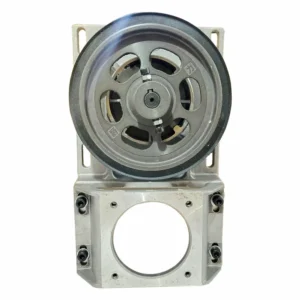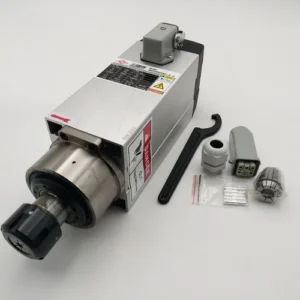Overview:
- Type: Water-Cooled CNC Spindle
- Primary Function: Provides rotational power to the cutting tool or bit in a CNC machine, while using water to cool the spindle and maintain its performance during extended or high-load operations.
Key Features:
- Cooling System:
- Water Cooling: Utilizes a closed-loop water cooling system to absorb and dissipate heat generated by the spindle during operation. The system includes a water pump, cooling lines, and a heat exchanger.
- Heat Dissipation: The water circulates through the spindle housing and absorbs heat, then transfers it to a heat exchanger or radiator where it is released into the environment.
- Construction and Materials:
- Housing: Made from high-strength materials such as aluminum or steel, designed to withstand the mechanical stresses and heat of high-speed operation.
- Water Jacket: Contains a water jacket or channels through which coolant flows to effectively transfer heat away from the spindle components.
- Power Ratings:
- Power Range: Available in various power ratings, typically ranging from 1.5 kW to 15 kW or more, depending on the spindle’s application and requirements.
- Selection: Power rating is chosen based on the specific needs of the machining task and the capabilities of the CNC machine.
- Speed Range:
- RPM: Offers a range of rotational speeds, commonly from 6,000 RPM to 24,000 RPM or higher. Adjustable speed settings allow for optimization based on the material being machined and the desired finish.
- Control: Speed can be controlled manually or through the CNC machine’s control system for precise adjustments.
- Tool Holders and Collets:
- Tool Holders: Equipped with tool holders or collets to secure cutting tools. Common types include ER collets, ISO collets, and other standard holders.
- Interchangeability: Allows for the use of various tool sizes and types, offering flexibility for different machining tasks.
- Performance Characteristics:
- Precision: Provides high precision and accuracy in machining operations, essential for detailed work and high-quality results.
- Durability: Designed to operate continuously at high speeds while maintaining temperature control, contributing to a longer service life.
- Noise Levels:
- Operation: Generally quieter than air-cooled spindles due to the efficient cooling system that reduces heat-related noise. However, some noise may still be generated by the water pump and cooling system.
- Maintenance:
- Cooling System: Regular maintenance of the cooling system is required, including checking coolant levels, inspecting for leaks, and ensuring proper flow.
- Cleaning: Keep the spindle and cooling system clean from debris and contaminants to maintain optimal performance.
- Inspection: Periodic inspection of the spindle for wear, noise, and alignment to ensure reliable operation.
- Installation:
- Mounting: Typically mounted using brackets or flanges that align with the CNC machine’s spindle mount. Accurate alignment is crucial for proper operation.
- Cooling System Setup: Requires setup of the water cooling system, including the installation of the water pump, coolant reservoir, and cooling lines.
Applications:
- Woodworking: Used for precise cutting, carving, and engraving of wood, MDF, and other similar materials.
- Metalworking: Suitable for machining metals such as aluminum, brass, and mild steel, where efficient cooling is essential to prevent overheating and tool wear.
- Plastic Machining: Ideal for processing various plastics like acrylic, PVC, and polycarbonate.
- Engraving: Effective for detailed engraving on a range of materials, including metals and plastics.
Benefits:
- Improved Cooling: The water cooling system provides efficient heat dissipation, allowing the spindle to operate at higher speeds and with greater power for extended periods.
- Enhanced Performance: Maintains optimal spindle temperature, which improves performance, accuracy, and tool life.
- Reduced Noise: Generally quieter operation compared to air-cooled spindles due to more effective heat management.
- Extended Service Life: Proper cooling helps prevent overheating and reduces wear, contributing to a longer lifespan of the spindle.
Considerations:
- Water Cooling Setup: Requires installation and maintenance of the water cooling system, including plumbing and coolant management.
- Cost: Typically more expensive than air-cooled spindles due to the additional cooling infrastructure.





Reviews
There are no reviews yet.